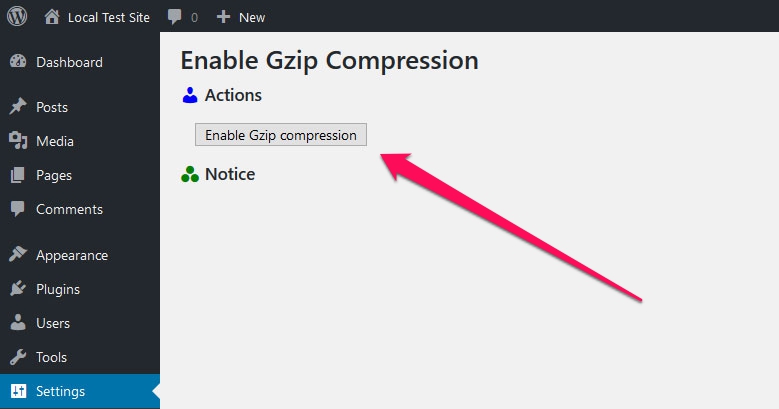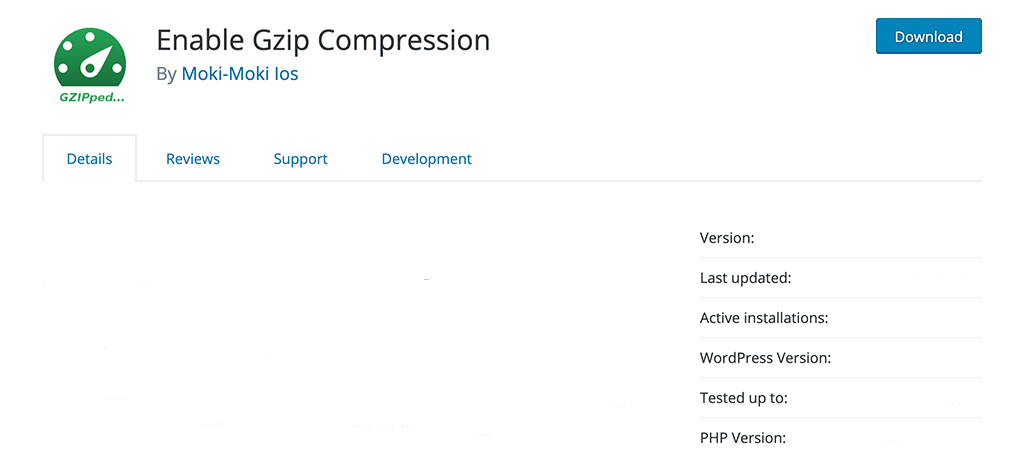Out of so many available options, a great way to speed up a WordPress site is GZIP, because it is fully capable of compressing the size of the files and make the site load faster. If you can enable GZIP compression WordPress, then you can be sure that your page gets to a blazing fast speed, even when settings like image compression have already been optimized.
Pagespeedy.io, as the name suggests, is able to skyrocket the speed of your website with a multi-dimensional approach towards WordPress optimization. Using Pagespeedy, you will notice that it performs most of the tasks for boosting your WordPress site speed on its own, and you will not be required to install separate plugins for caching, database optimization, JavaScript, and CSS minification.
What is GZIP compression?
GZIP is a well-known open-source compression method and works behind the scene to send as small data files as possible to your visitors. Although many people assume that anything that has a ‘G’ with its name can be a Google product, GZIP is not. GZIP is licensed by GNU and is superb at minimizing the file size.
Because GZIP is very useful, it is important to know how to enable GZIP compression in WordPress. Other than that, if one is running JS/CSS minification and image optimization, GZIP can crunch the website file sizes into the smallest ones. The extra-small files or the super-huge files are not hit by GZIP, and nor it works on images; it knocks down considerably what it compresses.
GZIP is able to take good, readable, and semantic code and mix it together in a way so that only the browsers are able to read it. The developers may not be able to see it because after the request is made, it is compressed on the fly. Therefore, one should not be worried about getting into the files and seeing a garbled mess.

How does GZIP compression work?
You must be able to know the meaning of compression and how it can be effective. At present, most of the sites use a blend of CSS, HTML, and JavaScript that the programmers compose in a way that is consistent and globally understood. The result is that the majority of it goes over the head and can serve nothing but human readability.
There is another fact that the majority of programmers use various design patterns and common elements, and this may lead to quite a bit of repetition. A compression algorithm like GZIP can utilize the designs and repeats detected in a text to generate a much more effective technique of collecting the data.
Even though the primary text may be exceedingly twice the size, but the compressed variant may use just a few characters and reduce the size by a whopping one-third. This clearly suggests that you will have a lot less to load and have a website with considerable speed.
Reasons for enabling and using GZIP compression
For a WordPress website, a good page loading speed can be an essential requirement. There are numerous strategies for WordPress website optimization that you can try out in order to make sure that you can have a smooth performance of your website. It can be quite simple to enable GZIP compression WordPress, and therefore, the majority of website owners make sure that it gets done.
If GZIP compression has not been enabled on your website, then there are chances that you may notice an error on the page speed tests by the popular speed testing tools. Many websites have developer tools that can be helpful to determine about GZIP compression being enabled like one can search for the Response Headers on Google Chrome developer tools.
Does your website come with default GZIP?
Some users may not be required to actually enable GZIP because they may already be using it without knowing. If you are able to go to Pingdom or GTmetrix speed test, you will be able to see whether or not it grades your site on compressing the site components. They may not give a good compression grade if the site components are not compressed.
Some people like to run multiple checks to see what is happening under the hood, even if they are getting a green result from the speed test. When you enable GZIP compression WordPress, then it can return you a quick answer that can specifically show you how and why GZIP is enabled or not.
GZIP might be enabled on your website and you may not know about it because of two main explanations. One of the major and the most common explanations is that GZIP might be already installed by default by some web host providers, thus automatically allowing algorithms, as it is essential for the servers to identify the browser requests.
The second reason is that your site might enable GZIP compression WordPress plugin. This is the reason why you have to look at .htaccess file in a proper way and thoroughly see the availability of the instructions. You may see lines like #GZIP Compression and mod_deflate rule enabled.
At this particular point, you will not be required to do anything else, but if you are still getting the messages for speed tests to enable GZIP, then the next step is to contact your hosting company’s support and ask the hosting provider to allow mod_deflate on the server.

How to enable GZIP compression in WordPress?
As a user, if you would like to assure that the resources like JavaScript, CSS, and HTML are served in a compressed form, you need to enable GZIP compression. This way, you will make sure that the web pages are loaded very fast on your website, because the speed of page loading of a website can possibly get affected by the huge uncompressed files.
You can follow a few common steps that are suggested by the experts in order to enable GZIP compression WordPress.
Enable GZIP compression WordPress htaccess
Among the most obvious approaches to enabling WordPress GZIP compression is to alter your .htaccess file. However, you may be required to modify your site’s code for this, and this can come with the risk of breaking something. You also need to understand that this particular server file is relatively sensitive, and if one small mistake is made, you should know that it can cause a lot of problems for you.
If you like to decrease the possibility of harming your WordPress website, then it gets necessary for you to save a duplicate of the primary data before you make any changes in it. You must also back up the WordPress website, and meanwhile, when you meet all of the conditions, you can then start working on it.
The .htaccess file must uniformly be in the website’s root folder, while the most reliable technique for you to determine this file is over the File Transfer Protocol (FTP) client. Once you are able to find this file, then you have the option to either edit it in a direct way or you can download the file to your computer prior to making any type of changes.
You have to protect this file in the end and upload it to your website’s server. If you enable GZIP compression htaccess WordPress, then your website should be running over a GZIP compression examiner tool, or you can also confirm the response headers to be certain that you achieved your goal.
GZIP compression enabled in NGINX or IIS
Although the bulk of shared hosting web plans head to move on Apache web servers, some people also use something else, i.e., NGINX or Microsoft’s IIS. It can be a little different to enable GZIP compression from the NGINX web servers.
If you are running on NGINX, next, you can allow GZIP compression by initiating the nginx.conf file and combine the code. On the other hand, if you are to run Microsoft IIS, then you need to examine Microsoft’s documentation surrounding how to enable GZIP compression in WordPress.

Reach out to the hosting service support team
Nowadays, GZIP compression is a web optimization strategy that is used quite commonly; therefore, a number of hosting services enable it by default. One can check it by using a number of approaches to make sure that it is enabled or not.
If you uncover that GZIP is not authorized on your website, then you always have the option to raise a support request to the hosting service provider. Although there are many hosting service providers available, the most popular of the providers will definitely oblige with your request.
For a WordPress starter who is not completely into the technical elements of a website, getting in contact with the customer support department is one of the best possible options as they are able to guide the user in a proper manner.
Enable GZIP compression by using plugins
Another very simple option available for you will be using a caching plugin with the GZIP compression support. This way, you will enable GZIP compression WordPress plugin in the settings. If the caching plugin is not having access to modify the files on your server, then you still need to ask your hosting service provider. The following is the list of some of the plugins that can be helpful to enable GZIP compression WordPress.
- PageSpeedy
PageSpeedy is considered to be the most powerful of the solutions that can help you with optimization and speed up your WordPress website. This cloud-based plugin requires no setup skills as it comes preconfigured. PageSpeedy can be helpful to compress HTML, CSS, and JavaScript files so that the web pages can load faster.
PageSpeedy is also helpful with the optimization aspects like page caching instant activation, preloading of cache in order to facilitate faster indexing by the search engines, flexible customization for the developer, and lazy loading of the images.
- Enable GZIP Compression
This is a very simple but powerful plugin that can be downloaded and used if the website is running on an Apache HTTP server. It can be specially used to enable GZIP compression, but if you are looking for some of the more advanced optimization features, then you can go for the premium version.
The premium version can help you enable GZIP compression and also help you to set the document to expire time, block any image hotlinking and allow image lazy loading. It is also quite compatible with WooCommerce and can therefore be used if you are running an online store.

This is another incredibly successful WordPress plugin that is able to help you with how to enable GZIP compression with WordPress. Once the plugin gets installed, the option can be enabled easily, along with a number of other options that can help you to optimize the performance of your website.
- WP Super Cache
WP Super Cache is also a well-known plugin that can be used to compress the files on your website. This option can be enabled in the plugin settings, and it is also able to help you in converting the dynamic files to static while serving the users.
Most of the users, such as the ones who did not log in, can go to the static version that can be quite easy to load. Therefore, it will be very helpful for you to make sure that the site is performing in an optimal manner.
- W3 Total Cache
This is a plugin that can help you a lot to improve the ranking in the search engine as well as the user experience of your WordPress website. There are a number of advanced features offered by W3 Total Cache in order to improve the website page load speed.
Its mean features include compression of JavaScript, HTML, and CSS files. Moreover, CDN integration is also offered in order to help you avoid any latency when you are serving your customers on the global level.
Wrapping up
GZIP compression is among the simplest of the speed fixes whether it is powered by WordPress or any other source. One of the greatest aspects of GZIP is that the majority of its users don’t even know about it, and it is already out there doing the job for them and resolving the issues regarding the page load speed in their websites. If there are any speed issues with your site, then it is in your best interest to enable GZIP compression WordPress.
If your tools and utilities send you a message that you don’t have GZIP enabled, then with a couple of clicks and the right plugins like PageSpeedy.io, you can do it. As you need a caching plugin for your WordPress speed improvement, then there can be nothing but a lot of positives for doing what needs to be done with GZIP.
Also Read: Top 20+ Free SEO Tools for 2021